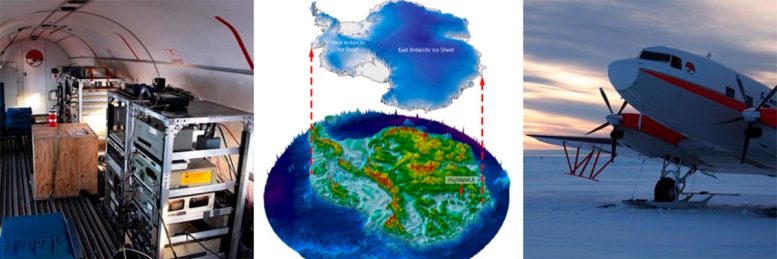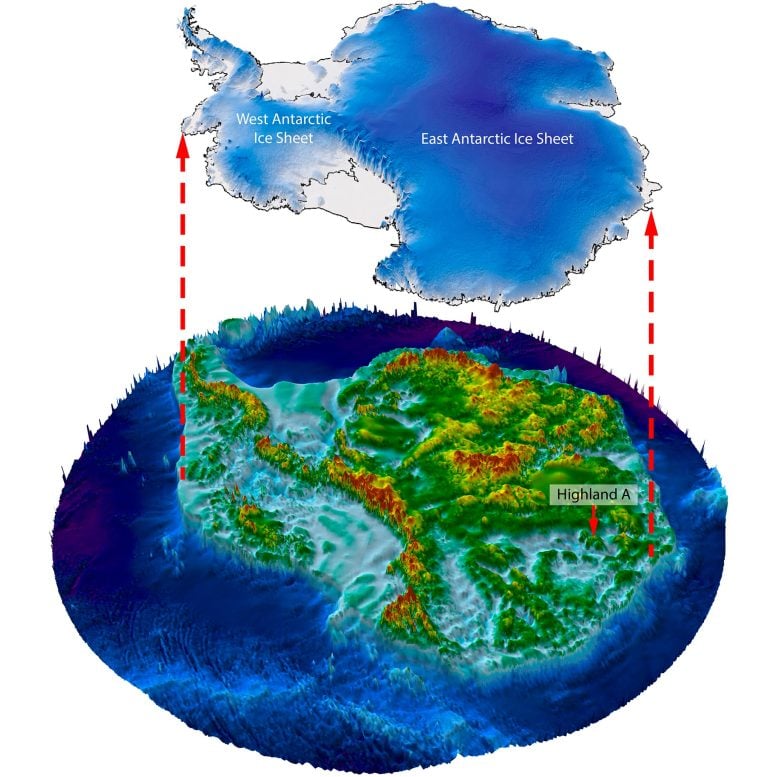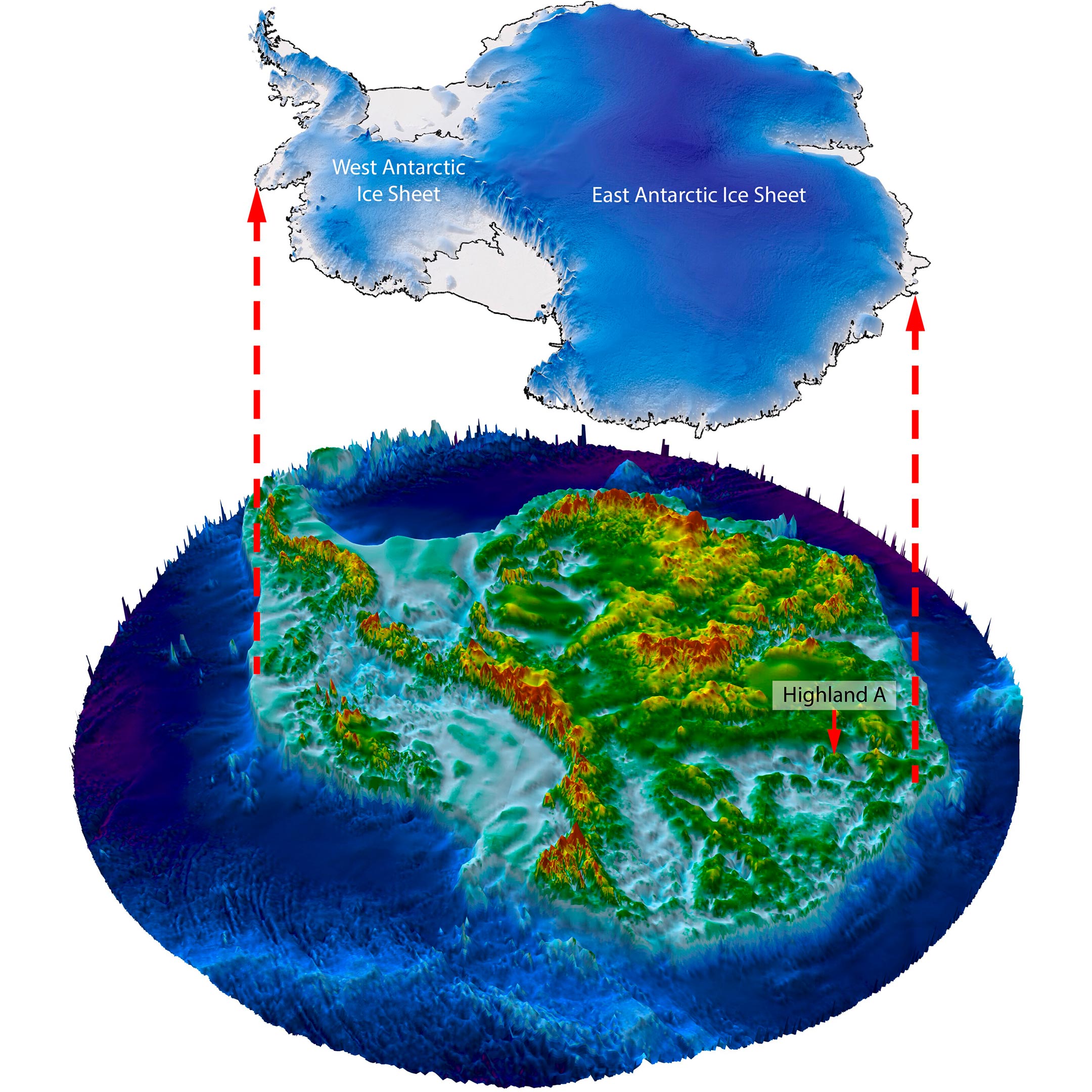
The left and right images show the aircraft and equipment used to conduct a partial survey of Antarctica during the ICECAP data collection project, courtesy of ICECAP. The central image shows what the Antarctic landscape would look like if the ice were lifted away, thanks to Stuart Jamieson.
Scientists have discovered an ancient river-shaped landscape beneath the Antarctic ice, providing valuable insights into the long-term stability of the ice sheet and responses to climate changes.
A research team, led by Durham University in the United Kingdom, used satellite data and radio echo sounding techniques to map a distance of 32,000 kilometres.2 An area of land under a vast ice sheet.
They discovered a landscape that appears to have been shaped by rivers at least 14 million years ago, perhaps even before the initial growth of East Antarctic ice about 34 million years ago.
This newly discovered landscape consists of ancient valleys and hills, not unlike the glacially modified landscapes of North Wales, UK, in size and scale.
Its presence indicates long-term stability in the temperature of the ice sheet in the region studied by the researchers.
The study was published in the journal Nature Communications.

What would Antarctica look like if its ice was removed? Photography: Stuart Jamieson
Implications for climate science
Lead author Professor Stuart Jamieson, from the Department of Geography at Durham University, UK, said: ‘The land beneath the East Antarctic ice sheet is less known than on the surface. Mars.
“And that’s a problem because this landscape controls the way ice flows in Antarctica, and it controls the way it might respond to past, present and future climate change.
“So, we are studying a small part of this landscape in more detail to see what it can tell us about the evolution of the landscape and the evolution of the ice sheet.
“And what we found is an ancient land surface that was not eroded by the ice sheet, and instead appears to have been created by rivers before the appearance of ice.
“This tells us that there hasn’t been a lot of change in this particular area, which suggests that although this part of the ice sheet may have retreated during warmer times in the past, conditions at this location probably haven’t changed much,” he said. This helps us understand how the ice sheet will respond to future and ongoing warming.
Research contributions and future exploration
“It is remarkable that this landscape, ‘hidden in plain sight’ for so many years, can tell us so much about the beginning of the Ice Age,” said study co-author Neil Ross, a professor of polar sciences and environmental geophysics at Newcastle University in the UK. and the long-term history of the East Antarctic ice sheet, as well as helping us understand how it will evolve in response to future climate change.
“This has been a slow-burn project, but now it has come to fruition in an exciting paper involving a fantastic research team.”
This discovery builds on previous work by this team who, in collaboration with other researchers, mapped hidden mountain ranges, canyon systems and subglacial lakes in Antarctica.
Although the scene beneath the ice sheet is not visible to the naked eye, satellite images taken over the area show small ripples in the surface of the ice sheet that provide clues about the scene beneath the ice.
In a few places, the presence of the landscape has been confirmed using radio echo sounding from aircraft to see the ice and map the shape of the ground beneath the ice sheet.
The research team suggests that there are likely other ancient landscapes, yet to be discovered, hidden beneath the East Antarctic ice sheet.
Professor Jamieson added: “We will continue to explore the landscape, doing our best to fill in the gaps where surveys are lacking, and use that information to understand how the ice sheet and the underlying landscape have changed over its long history.”
Reference: “An ancient river landscape preserved beneath the East Antarctic ice sheet” by Stuart S. R. Jamieson, Neil Ross, J. G. Paxman, and Fiona J. Klopp, Duncan A. Young, Shuai Yan, Jamin Greenbaum, Donald D. Blankenship, and Martin J. Siegert, October 24, 2023, Nature Communications.
doi: 10.1038/s41467-023-42152-2
Survey data collection supporting this work was supported by the Natural Environment Research Council (NERC) of the United Kingdom Research and Innovation (UKRI), the US National Science Foundation (NSF), and the US National Science Foundation (NSF). NASA.

“Typical beer advocate. Future teen idol. Unapologetic tv practitioner. Music trailblazer.”







More Stories
Boeing May Not Be Able to Operate Starliner Before Space Station Is Destroyed
How did black holes get so big and so fast? The answer lies in the darkness
UNC student to become youngest woman to cross space on Blue Origin